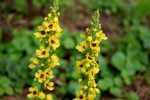 Native to Eurasia and North Africa, moth mullein was introduced into the US before 1818 and has naturalized in disturbed areas such as roadsides and fencerows in most of the country especially the East coast. It is a biennial and a member of the figwort family, Scrophyulariaceae, that also includes twinwspur and Nemesia. Although plants prefer full sun and rich soil they tolerate less.
Native to Eurasia and North Africa, moth mullein was introduced into the US before 1818 and has naturalized in disturbed areas such as roadsides and fencerows in most of the country especially the East coast. It is a biennial and a member of the figwort family, Scrophyulariaceae, that also includes twinwspur and Nemesia. Although plants prefer full sun and rich soil they tolerate less.
Description: In the first year moth mullein produces a basal rosette of dark green leaves up to 16″ wide with each leaf having toothed margins and being up to 8″ long. The summer to fall of the second year the plant sends up a slender flowering stalk that is unbranched and 2-5′ tall. It bears leaves up to 5′ long and a spike of 1″ wide flowers with five petals surrounding orange stamens with purple hairs. Flowers give way to capsules containing numerous seeds that spread the plant. A deep taproot with a fibrous root system anchors the plant.
Control: Because the plant is a biennial and spreads by seeds, removal of flowers before seed set is essential to control. Individual plants can be hand dug when young before the taproot becomes established. In severe cases a selective herbicide such as 2,4 D is effective.